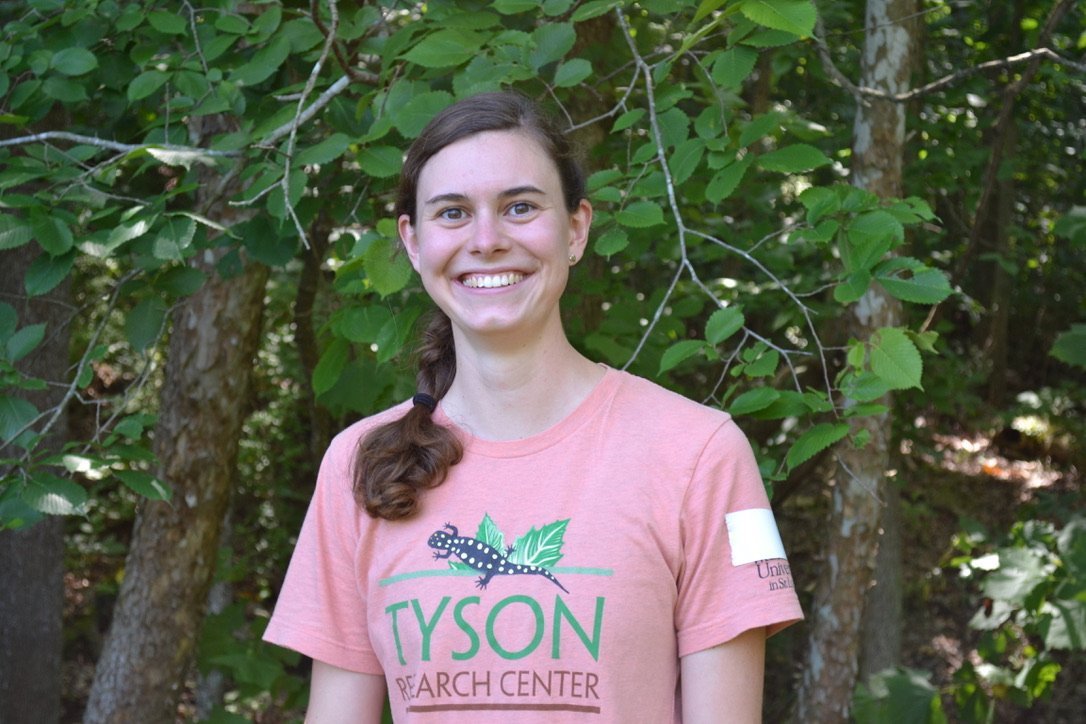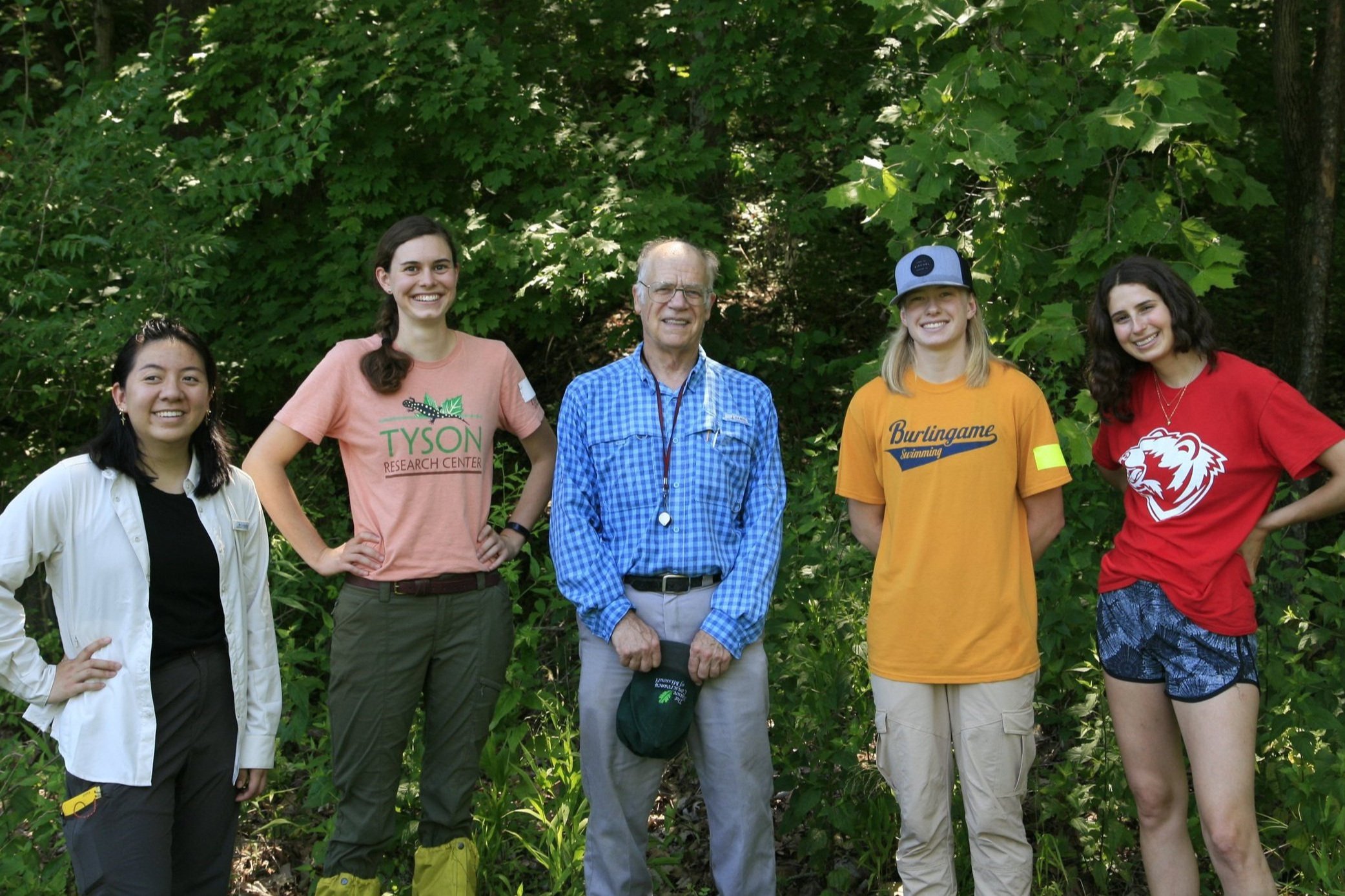Humans of Tyson 2023
Erin O’Connell
she/her
Tyson Research and Conservation Project Coordinator
Team Flora
I’m leading a new team, Team Flora, at Tyson this summer. Our goal is to inventory every single species of plant that is at Tyson and to create a vouchered list – so every species will have a physical representative plant that we collect. We'll press and preserve them, and then donate them to the Missouri Botanical Garden where they will be preserved forever, ideally. That way in the future, if anyone reads our document, they can actually go and look at those records with the physical plant. So, you know, easy peasy. It's only 2000 acres.
I personally started this project a little bit in the spring. We had a phenology monitoring project that we were doing, so every time I was going out to monitor phenology, I would also check for plants in those places. And Doug Ladd, who is co-PI of this project, teaches classes at Tyson sometimes – whenever he's been here in the last three or four years, he's collected plants. Both of us have had a small collection started.
We're hoping it can be a resource for researchers that come to Tyson. A lot of times when we're collaborating with other institutions, they might not be familiar with Ozarks. So we can say, here's a list of the things you might find that narrows it down from the 3000 plants of Missouri to a few hundred, hopefully. And if we know the habitat type, it could be an even shorter list. It'll give them a little bit more context for designing experiments and picking which species they want to use. They won’t have to do the work that we're doing this summer, of figuring out what the full list of possibilities could be.
It’s also for our own land management. We don't really actively manage Tyson – of course the roads are maintained, which is awesome, but we're not doing large prescribed burns, we're not doing big removals. We do remove honeysuckle, but we don't have a whole hired crew to remove honeysuckle. So hopefully with this project we could target some of the places that have higher diversity or rare and unique species to Tyson, and then focus some of our limited management resources on those locations within Tyson.
“What we’re doing is more like traditional botany, which is somewhat standardized, but there’s a lot of variation in how people go about it. I’m enjoying the open ended-ness. Our job is to go explore, and the more you discover, the better.”
When I was beginning this project, I figured I should probably see what lists of plants we already have, as a starting place. And then I realized, wait, we have lots of different lists from projects over the years. And it turned into this whole deep dive of trying to figure out who all has ever done plant research at Tyson. So it's been a deep dive of just trying to figure out what people have documented in the past.
There aren't a lot of vouchers – well, there were vouchers, but unfortunately they were stored in a bunker, and the dehumidifier broke, and everything kind of molded through. It wasn't a very good long-term storage plan. We lost a lot of the really early and middle historic collections.
There are also some really early collections at the Missouri Botanical Garden. So that's another thing we've been doing – we did a search in their database and pulled up a list of the actual specimens that say they were collected at Tyson – a lot of them are from the early 1900s. We're trying to track those down.
Overall, it's very fun because our goal is clear and simple, but the way of getting there is fairly open-ended. That's a bit different from some other projects I've worked on that use established protocols that are standardized, sometimes nationally or even globally. What we're doing is more like traditional botany, which is somewhat standardized, but there's a lot of variation in how people go about it. I'm enjoying the open ended-ness. Our job is to go explore, and the more you discover, the better.
It's a little bit different than some other projects that I’ve worked on, that were either very space-oriented or time-oriented. Usually it’s like, okay, we're going to cover this patch of land one square meter at a time. Or we have to monitor something over the course of the year. This project is more taxonomically focused, so we're not necessarily going to every square meter of the 2000 acres – although we are trying! There is some timing element because we have to collect plants when they're flowering or fruiting. But our progress isn't measured those ways – we can't say we've covered this much space or this much time. We have to say we've covered this many species, and that's not a concept that people necessarily think about regularly. Like, how many is a lot of species? People know how big their backyard is or how long they spent in a place, but a number of species is a little less intuitive. It's a little bit harder to give a progress report, but also in some ways there is a bit less pressure because the more we find, the better. There's not really a way to fail.
For me personally, it's been fun going to different places that are also part of Tyson. There have been a couple of times that we're outside in a new ecosystem just looking around and I'm like, wow, I'm at work right now. This is what I normally do on my weekends, but I'm getting to do it professionally!



